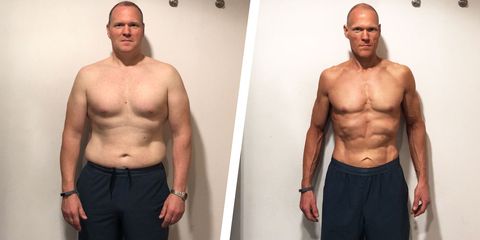A Few Tweaks to His Diet Helped This Guy Get Ripped in His Forties
• Years of overeating caused Steve Collins to steadily gain weight, topping out at nearly 270 pounds.
• In his forties, Collins committed to healthier eating habits and started working out with a personal trainer several days a week.
• As a result, Collins lost nearly 60 pounds and is now healthier and fitter than ever.
Steve Collins had always been a bigger guy—hence his nickname, “Big Steve.” Until recently, however, the nickname wasn’t just a reference to his height—at 6’3″, the London-based accountant towers over the average guy. At his peak, Collins, 44, was also carrying a lot of extra weight around, tipping the scales at nearly 270 pounds.
“My height actually hid a lot of sins—in public, at least,” he says. “Shirt off in front of the mirror was a different story.” While junk food wasn’t necessarily to blame—Collins says he ate his last Whopper in the ’90s—his voracious appetite still proved difficult to satisfy, and in an average day, he would wind up overeating.
“I was quite surprised when I logged my consumption on an average weekend and realized I was eating between 4,000 and 5,000 calories,” he says. Collins had recently turned 40, and was discussing all the things he wanted to accomplish over the next decade. A friend of his replied offhandedly, “That’s if we’re all still here.” It didn’t sit well with Collins.
“Reflecting later on that throwaway comment made me realize that if one of us wasn’t making it to 50, it was likely be me,” he says. His fears, it turns out, were well founded: Both of his parents had passed away in their fifties. Suddenly, he felt more determined than ever to take control of his health.
“I had to stop kidding myself, stop being a ‘tourist’ at the gym, and admit that I didn’t really know what I was doing,” he says. “I’d never been coached or followed a proper training program or been taught good form. My conclusion was that I could do more and do better with my body.”
As luck would have it, Collins was on a work flight when he opened the inflight magazine and saw a full-page ad for the gym Ultimate Performance, also known as “UP.”
For Collins, it proved to be an easy sell—he signed up immediately for a six-week transformation program. The first step Collins took with his new trainer was to finally start paying closer attention to what he ate. He started by tracking his macros—his fat, carb, and protein intake—for the first time ever. He also followed a high protein, moderate fat, low-carb diet. Then he met up with his trainer, Alastair Woodward, a nationally competitive powerlifter, to begin his workouts.
Collins performed three full body workouts a week with Woodward, focusing on large compound movements with heavy weights, focusing on form. He also performed about two hours of steady state cardio on his own—aiming for at least 15,000 steps a day, minimum.
“The scales started winding down immediately,” he says. For eight weeks straight, he lost nearly six pounds a week. While his original goal was to lose 22 pounds and five percentage points of body fat, it started to become obvious that he was going to crush that goal significantly. So he and his trainer moved the goalposts—setting a more ambitious target of 44 pounds by the end of the program.
“People that I had known for years literally didn’t recognize me. One afternoon at work I had no fewer than seven people ask me what had happened to me in the space of two hours,” he says. “That was when I realized we were doing something rather special.”
Like most people, the major hurdles for Collins arrived during major holidays and events like his birthday, Christmas, and a two-week holiday in Brazil. But even facing those obstacles, Collins gradually worked his way down to 181 pounds for a total of 61 pounds lost.

Steve Collins
“Like Oscar Wilde, I can resist everything except temptation—in particular, chocolate and churrasco,” he says. “Let’s just say it wasn’t a straight line down from 242 to 181—and realistically, it never could be.”
The key to all “setbacks,” Collins says, is that what is done is done—it’s all about how you respond. The first step is to have a potentially difficult, but honest conversation with yourself about motivation: “Is the goal more important for you than the sacrifice?” he says. Once you’ve committed to losing weight, make a concrete plan and find the proper support to achieve it.
“Ultimately, weight loss is a simple equation of calories in versus calories out, and then preserving your muscle tissue as best you can while you’re losing weight. It takes a huge amount of mental discipline to carry on,” he says. In other words, the key isn’t thinking, it’s doing.
“When you find what works for you, you’ll be amazed at how conceptually simple it is and wonder how and why you didn’t do it before. And, like me, when the numbers on the scales start going down, it just spurs you on to keep things that way.”
Source: Read Full Article



